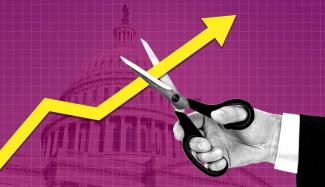
Is this rate cut cycle different?
As the US moved into Q4 of 2024, the battle against historically high inflation appeared to be won. Inflation, from its highest level of 9.1% (June of 2022), had retreated all the way back to just 2.4%. Though still above the Fed mandate of 2.0%, investors were relieved as inflation is viewed as a negative for the stock market because it starts a chain reaction of increased borrowing and input costs (materials and labor), a subsequent lowering of expectations for earnings growth and the resultant downward pressure in stock prices. With inflation fears easing, the Fed was able to begin a long-anticipated process of rate reduction with a first rate cut of 50 bps at its September 17-18 meeting. This was the first rate cut by the Fed in over 4 years. Additional cuts followed on November 6-7 (25 bps) and then December 17-18 (25 bps), which cuts together with the large cut in September dropped the federal funds rate – the rate banks charge to lend each other money – from a range of 5.25% to 5.50% in September to 4.25% to 4.50% in December. The theory behind rate cuts is that reducing the fed rate makes money cheaper and encourages banks to borrow more and subsequently extend more credit to borrowers. While changes in the fed rate can impact the entire yield curve, typically we would expect short term lending rates (auto loans and credit cards) to be impacted the most. Mortgage rates also respond to easing monetary policy, though greater impact comes from changing expectations in the outlook for economic growth and inflation.
So how have market interest rates responded to the three 2024 rate cuts? Not as expected. Historically, rate-cutting cycles have been associated with falling US Treasury rates. But not this time. If we look at the benchmark 10-year US Treasury rate (TNX), we see that during the period of the three rate cuts TNX climbed from September 17-18 (3.68%) to November 6-7 (4.34%) and then to December 17-18 (4.49%). At the time of this writing, TNX has declined a bit to 4.23% after hitting a 2025 high mark of 4.80% on January 13th. While disappointing for bond holders and prospective mortgage applicants, this move higher by TNX is not all bad news for the economy or financial markets. It is, however, important to understand what is happening, as the forces behind this rise in market yields could impact both the economy and investment returns in the year ahead.
So why the rise in yields? The inflation fight is not over. Since the September CPI reading, we have seen inflation drift higher each month from 2.4% to 2.6% to 2.7% to 2.9% and then to 3.0% in January. While the trending data is quite clear, it is the additional inflationary impact of Trump 2.0 – uncertainty on a long list of policy initiatives including tariffs, restrictive immigration policies, tax cuts, loosening of regulations and a higher expected path for federal deficits that together provide the greatest potential to boost inflation. It is these new potential drivers of expected higher inflation that have many investors worried, and a Fed now poised to be far more cautious in its approach in moving US monetary policy to a more neutral policy stance. What else is different with this cycle? For one, the US economy remains in solid shape. The US employment picture remains generally good with over 2 million jobs created in 2024 and a year-end unemployment rate of 4.1%. GDP will finish at about 2.5% for 2024, consumer spending remains resilient and in broad terms US households remain in good financial shape. History also suggests that the Fed typically cuts rates in times of crisis – Covid (2020), Global Financial Crisis (2007-09) and Dotcom Bust (2000-01) – not this time. The lack of crisis and strong US economy will allow the Fed to take an extra measure of caution and be patient in determining the timing of additional cuts, with the smart money seeing only one or possibly two cuts (25 bps each) in 2025.

